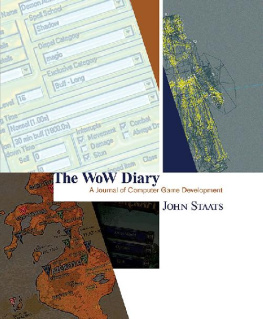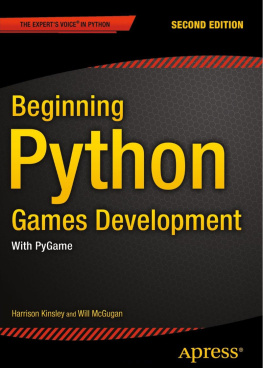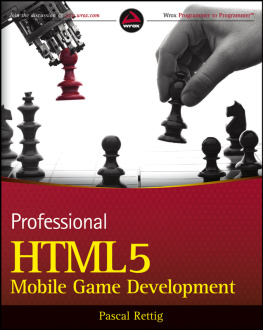
About the Author
John Staats was born and raised in Akron, Ohio. Heearned a BFA from Kent State Universitys Visual Communication Design programand spent ten years in advertising in NYC. Before joining Blizzard he haddecades of amateur level design experience, from tabletop games to first-personshooters. His homepage, whenitsready.com, marks the progress of his variousprojects, including an upcoming board game based on dungeon crawls.
John built 90 percent of Vanilla WoWs non-instancedcaves, crypts, dens, mines, and hive tunnels. His Vanilla WoW portfolioincludes:
AhnQiraj Temple
Blackfathom Deeps
Blackwing Lair
Blackrock Mountain
Blackrock Depths
Booty Bay
Karazhan (w/Aaron Keller)
Loch Modan Dam
Lower Blackrock Spire
Molten Core
Razorfen Downs
Razorfen Kraul
Scholomance
The Slag Pit
Upper Blackrock Spire
The Wailing Caverns
Warsong Gulch (w/Matt Milizia)
T he Wo W Diary
AJournal of Computer Game Development
J ohn S t a a ts

Copyright 2018 by John Staats. All rights reserved. No part of this work covered by thecopyright hereon may be transmitted or reproduced or used in any form or by anymeans without written permission of the publisher, except in the case of briefquotations embodied in criticalarticles and reviews.
Artwork, Photographs, Images, Logos 2018 BlizzardEntertainment. Warcraft, World of Warcraft, and Blizzard Entertainment aretrademarks or registered trademarks of Blizzard Entertainment, Inc., in theU.S. and/or other countries. All other trademarks referenced herein are the properties of their respectiveowners.
Libraryof Congress Control Number: 2017908847
ISBN:978-0-9990824-0-9
Printedin the United States of America
FirstEdition February 2018
Design and spot illustrations by John Staats
Edited by Ben Way, Jim Spivey, Dan Foster, andScout Festa
Publishedby whenitsready LLC
9101W. Sahara Ave., Suite 105-1448, Las Vegas, NV 89117
www.whenitsready.com
For Team 2, both old and new
Table of Contents

I imagined the space shuttle blueprints were going to be thelargest project Id ever work on. I was wrong. Our games editor has more linesof code.
David Ray, World of Warcraft database/toolsprogrammer
Atits November 2004 launch, World of Warcraft (WoW) was the biggest gameever made, pushing past two million lines of code, roughly four times the sizeof most top-tier computer games. Its development team and budget were largerthan any of Blizzard Entertainments previous projects. Its subscriber basegrew to the size of the worlds biggest cities and generated a virtual goodseconomy comparable to the GDP of small nations. The company grew from hundredsto thousands of employees, the bulk of whom were customer servicerepresentatives who became Blizzards single costliest expenditure. At launch,the interface, quests, and game elements used over a million words thattranslated into six languages. There were almost nine thousand types ofmonsters or non-player characters (NPCs) in the game. The most varied creaturewas the ogre (170 versions), followed by the murlock (100 versions). UntilYouTube began streaming videos a year later, WoW servers handled over 10percent of global Internet bandwidth in downloads, and its players contributedto roughly half of active global Internet traffic at any given time. The sunnever sets on the Warcraft empire.

Titan was a canceled project whose assets were used forOverwatch. Although nothing I created was used by Overwatch, it was niceto be included in the acknowledgments. Blizzards classy move of thankingeveryone who contributed to the doomed Project Titan emboldened me to finishthe story about making World of Warcraft so people might appreciate howhard it is to make computer games. Images provided courtesy of BlizzardEntertainment, Inc.
May 2016:
Preface
I am writing this inlate May 2016, days after Blizzards newest title, Overwatch, haslaunched. My former team leader and ex-roommate Shane Dabiri shared a Facebookpost celebrating Blizzards latest title, which prompted me to recall the timewhen Shane and I saw each other every day while we worked on World ofWarcraft. Although we drifted apart after WoW shipped in November 2004,whenever we saw each other he often asked, What ever happened to that Worldof Warcraft diary you were working on? Everyone wants to read it! Isometimes got this question when I reconnected with anyone from the old crew.Everyone on the team knew I was writing a developer diary, since Id spentfour years interviewing people about their jobs and keeping tabs on the gamesincremental progress. Seeing Shanes Facebook post about Overwatchinspired me to polish and publish this four-year time capsule about making thegame now referred to as Vanilla WoW.
I haveonly a diminished view of WoW these days. Is Vanilla the correct term? Or isit Classic? I have no idea. I neither make nor play computer games anymore. Ionly recently learned Blizzard was shipping an expansion called Legionduring a conversation with friends while playing a tabletop role-playing gamecalled Pathfinder. In terms of computer games, I am, as I once was, outof the loop.
Thereason I wrote this diary has its roots in my life before game development. Ididnt come from a place where computer games were made, nor did I know anyonein the software or entertainment industry. I was born and raised in Akron,Ohio, and spent ten years working in Manhattan ad agencies after graduatingcollege. Until I began editing games myself in the mid-1990s, Id never knownanyone in the electronic entertainment industry, and so the process ofdeveloping computer games remained an impenetrable mystery. After the Internetgave everyone access to everything, gaming fans began connecting withdevelopers. My introduction to this community was playing first-person shooter(FPS) online games, whose most popular titlesQuake and Unrealcateredto hobbyists who modified their games into new versions, called mods. When Ilearned there were mod tools that would allow me to build my own 3D levels, Ibought my first PC the very next day (I had played games on my roommatesmachines until that point) and built my own first-person shooter levels over thenext five years. I soon joined a group of fellow artists and programmers, a modteam, called Lokis Minions Capture the Flag, and began learning the basics. Iworked tirelessly at my new hobby, putting in over-one-hundred-hour weeks onmods when I was between advertising campaigns.
First-personshooters were in their heyday in the mid to late nineties for the simple reasonthat they supported the only worldwide 3D gaming community, and many FPS gamedevelopers (known as devs) worked in a spotlight. Devs published dailyupdates about their development progress, which gave fans like me the firstinkling into what kind of effort went into making games. Many pros becamesubculture celebrities, and magazines wrote stories about these Game Gods.Some became popular because they were the best in the business, while otherswere prolific writers or had outlandish personalities. I, too, found Game Godsentertaining and dreamed of becoming one in my own right someday. After fiveyears of modding, Id inadvertently developed a respectable portfolio oforiginal 3D levels, and when someone from my mod team told me Blizzard washiring level designers, I applied in the summer of 2000.




![Mark J. P. Wolf (editor) - Encyclopedia of Video Games: The Culture, Technology, and Art of Gaming [3 volumes]](/uploads/posts/book/279290/thumbs/mark-j-p-wolf-editor-encyclopedia-of-video.jpg)







